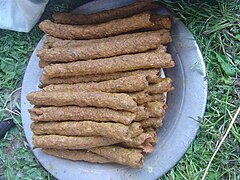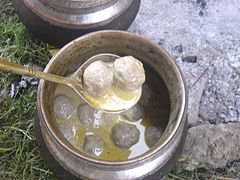Wazwan: Difference between revisions
Created page with "{{Short description|Meal in Kashmiri cuisine}} {{Infobox food | name = Wazwan | image = File:Wazwan trami full.jpg | image_size = 317px | caption = Complete {{Transliteration|ks|wazwan}} on one platter (or {{Transliteration|ks|traem}}). | region = Kashmir | place_of_origin = Kashmir | served = Hot | main_ingredient = Mutton}} '''{{Transliteration|ks|Wazwan}}''' ({{IPA|ks|ʋaːzɨʋaːn}}) is a multi-course meal in Kashmiri cuisine, origi..." |
Marked this version for translation |
||
| (One intermediate revision by the same user not shown) | |||
| Line 1: | Line 1: | ||
<languages /> | |||
<translate> | |||
<!--T:1--> | |||
{{Short description|Meal in Kashmiri cuisine}} | {{Short description|Meal in Kashmiri cuisine}} | ||
{{Infobox food | {{Infobox food | ||
| Line 10: | Line 13: | ||
| main_ingredient = [[Lamb and mutton|Mutton]]}} | | main_ingredient = [[Lamb and mutton|Mutton]]}} | ||
<!--T:2--> | |||
'''{{Transliteration|ks|Wazwan}}''' ({{IPA|ks|ʋaːzɨʋaːn}}) is a multi-course meal in [[Kashmiri cuisine]], originating from [[Kashmir]]. It is a unique component of Kashmiri culture. | '''{{Transliteration|ks|Wazwan}}''' ({{IPA|ks|ʋaːzɨʋaːn}}) is a multi-course meal in [[Kashmiri cuisine]], originating from [[Kashmir]]. It is a unique component of Kashmiri culture. | ||
<!--T:3--> | |||
Almost all the dishes are meat-based using lamb, beef or mutton with few vegetarian dishes. It is popular throughout the larger [[Kashmir]] region. Moreover, Wazwan is also served internationally at Kashmiri food festivals and reunions. | Almost all the dishes are meat-based using lamb, beef or mutton with few vegetarian dishes. It is popular throughout the larger [[Kashmir]] region. Moreover, Wazwan is also served internationally at Kashmiri food festivals and reunions. | ||
all dishes are prepared according to halal standards. For vegetarians, there are distinctive delicacies such as Dum Alve, Nadur (lotus stem), Haakh (collard greens), Kashmiri vegetarian pulao is a flavorful dish prepared with aromatic Kashmiri spices, vegetables, and a mix of dried fruits, creating a rich and delightful culinary experience. | all dishes are prepared according to halal standards. For vegetarians, there are distinctive delicacies such as Dum Alve, Nadur (lotus stem), Haakh (collard greens), Kashmiri vegetarian pulao is a flavorful dish prepared with aromatic Kashmiri spices, vegetables, and a mix of dried fruits, creating a rich and delightful culinary experience. | ||
<!--T:4--> | |||
==History== | ==History== | ||
[[Image:Rista prep.jpg|thumb|{{Transliteration|ks|Waza}} preparing {{Transliteration|ks|rista}}]] | [[Image:Rista prep.jpg|thumb|{{Transliteration|ks|Waza}} preparing {{Transliteration|ks|rista}}]] | ||
In the Kashmiri language, {{Transliteration|ks|waz}} means 'cook' or 'cooking' and {{Transliteration|ks|wan}} means 'shop'. The ultimate formal banquet in Kashmir is the royal {{Transliteration|ks|wazwan}}. Of its thirty-six courses, between fifteen and thirty can be preparations of meat, cooked overnight under the supervision of a master chef called a {{Transliteration|ks|wouste waze}}. Guests are seated in groups of four and share the meal out of a large copper plate called the {{Transliteration|ks|traem}}. A ritual washing of hands in a portable basin called the {{Transliteration|ks|Tash-t-naer}}, which is taken around by attendants. Then the {{Transliteration|ks|traem}} arrives, heaped with rice, quartered by two [[seekh kabab]]s and contains four pieces of {{Transliteration|ks|methi maaz}}, (mutton intestines flavored with a spice mixture containing dried [[fenugreek]] (methi) leaves), two {{Transliteration|ks|tabakh maaz}} (twice-cooked lamb ribs, initially braised with ground spices, then browned in ghee), one {{Transliteration|ks|safed kokur}} (chicken with white sauce), one {{Transliteration|ks|zafran kokur}} (chicken with saffron sauce), and the first few courses. [[Yogurt]] and [[chutney]] are served separately in small earthen pots. Up to about 20 items are served thereafter by {{Transliteration|ks|waza}} (the junior cook). Seven dishes are a must for these occasions — {{Transliteration|ks|tabakh maaz}}, {{Transliteration|ks|rista}} (meatballs in a red, paprika-saffron-fennel spice gravy colored with [[Alkanna tinctoria|dyer's alkanet]]), [[rogan josh]], {{Transliteration|ks|daniwal korma}} (lamb roasted with yoghurt, spices and onion puree, topped with [[cilantro|coriander]] leaves), {{Transliteration|ks|aab gosh}} (lamb chunks cooked with a fennel-based spice mixture, cardamom and partially evaporated milk), {{Transliteration|ks|marchhwangan korma}} (chicken legs/thighs cooked in a spicy browned-onion sauce) and {{Transliteration|ks|gushtaba}} (meatballs cooked in a spicy yoghurt gravy). The main course usually ends with {{Transliteration|ks|gushtaba}}. The {{Transliteration|ks|gushtaba}} is a large meatball which signals the end of the main course. After that, desserts are served. In winters, the dessert can be a hot sweet dish and in summers, it is usually something cold. | In the Kashmiri language, {{Transliteration|ks|waz}} means 'cook' or 'cooking' and {{Transliteration|ks|wan}} means 'shop'. The ultimate formal banquet in Kashmir is the royal {{Transliteration|ks|wazwan}}. Of its thirty-six courses, between fifteen and thirty can be preparations of meat, cooked overnight under the supervision of a master chef called a {{Transliteration|ks|wouste waze}}. Guests are seated in groups of four and share the meal out of a large copper plate called the {{Transliteration|ks|traem}}. A ritual washing of hands in a portable basin called the {{Transliteration|ks|Tash-t-naer}}, which is taken around by attendants. Then the {{Transliteration|ks|traem}} arrives, heaped with rice, quartered by two [[seekh kabab]]s and contains four pieces of {{Transliteration|ks|methi maaz}}, (mutton intestines flavored with a spice mixture containing dried [[fenugreek]] (methi) leaves), two {{Transliteration|ks|tabakh maaz}} (twice-cooked lamb ribs, initially braised with ground spices, then browned in ghee), one {{Transliteration|ks|safed kokur}} (chicken with white sauce), one {{Transliteration|ks|zafran kokur}} (chicken with saffron sauce), and the first few courses. [[Yogurt]] and [[chutney]] are served separately in small earthen pots. Up to about 20 items are served thereafter by {{Transliteration|ks|waza}} (the junior cook). Seven dishes are a must for these occasions — {{Transliteration|ks|tabakh maaz}}, {{Transliteration|ks|rista}} (meatballs in a red, paprika-saffron-fennel spice gravy colored with [[Alkanna tinctoria|dyer's alkanet]]), [[rogan josh]], {{Transliteration|ks|daniwal korma}} (lamb roasted with yoghurt, spices and onion puree, topped with [[cilantro|coriander]] leaves), {{Transliteration|ks|aab gosh}} (lamb chunks cooked with a fennel-based spice mixture, cardamom and partially evaporated milk), {{Transliteration|ks|marchhwangan korma}} (chicken legs/thighs cooked in a spicy browned-onion sauce) and {{Transliteration|ks|gushtaba}} (meatballs cooked in a spicy yoghurt gravy). The main course usually ends with {{Transliteration|ks|gushtaba}}. The {{Transliteration|ks|gushtaba}} is a large meatball which signals the end of the main course. After that, desserts are served. In winters, the dessert can be a hot sweet dish and in summers, it is usually something cold. | ||
==List of main dishes== | ==List of main dishes== <!--T:5--> | ||
<!--T:6--> | |||
* '''[[Maithi maaz|Methi Maaz]]''' (Tripe cooked with spices) | * '''[[Maithi maaz|Methi Maaz]]''' (Tripe cooked with spices) | ||
* '''[[Rista|Riste]]''' ([[meatball]]s in a fiery red gravy) | * '''[[Rista|Riste]]''' ([[meatball]]s in a fiery red gravy) | ||
| Line 39: | Line 46: | ||
* '''[[Muji chetin]]''' (radish and walnut chutney) | * '''[[Muji chetin]]''' (radish and walnut chutney) | ||
<!--T:7--> | |||
<gallery mode="packed" caption="Wazwan varieties"> | <gallery mode="packed" caption="Wazwan varieties"> | ||
File:TabakMaaz wazwan.jpg |Tabak maaz | File:TabakMaaz wazwan.jpg |Tabak maaz | ||
| Line 48: | Line 56: | ||
</gallery> | </gallery> | ||
<!--T:8--> | |||
==See also== | ==See also== | ||
{{portal|Food}} | {{portal|Food}} | ||
| Line 60: | Line 69: | ||
{{div col end}} | {{div col end}} | ||
<!--T:9--> | |||
[[Category:Kashmiri cuisine]] | [[Category:Kashmiri cuisine]] | ||
[[Category:Lamb dishes]] | [[Category:Lamb dishes]] | ||
| Line 66: | Line 76: | ||
[[Category:Culture of Kashmir]] | [[Category:Culture of Kashmir]] | ||
{{二次利用|date=9 May 2025, at 19:34}} | {{二次利用|date=9 May 2025, at 19:34}} | ||
</translate> | |||
Latest revision as of 14:05, 12 June 2025
 Complete wazwan on one platter (or traem). | |
| Place of origin | Kashmir |
|---|---|
| Region or state | Kashmir |
| Serving temperature | Hot |
| Main ingredients | Mutton |
Wazwan (ks) is a multi-course meal in Kashmiri cuisine, originating from Kashmir. It is a unique component of Kashmiri culture.
Almost all the dishes are meat-based using lamb, beef or mutton with few vegetarian dishes. It is popular throughout the larger Kashmir region. Moreover, Wazwan is also served internationally at Kashmiri food festivals and reunions. all dishes are prepared according to halal standards. For vegetarians, there are distinctive delicacies such as Dum Alve, Nadur (lotus stem), Haakh (collard greens), Kashmiri vegetarian pulao is a flavorful dish prepared with aromatic Kashmiri spices, vegetables, and a mix of dried fruits, creating a rich and delightful culinary experience.
History

In the Kashmiri language, waz means 'cook' or 'cooking' and wan means 'shop'. The ultimate formal banquet in Kashmir is the royal wazwan. Of its thirty-six courses, between fifteen and thirty can be preparations of meat, cooked overnight under the supervision of a master chef called a wouste waze. Guests are seated in groups of four and share the meal out of a large copper plate called the traem. A ritual washing of hands in a portable basin called the Tash-t-naer, which is taken around by attendants. Then the traem arrives, heaped with rice, quartered by two seekh kababs and contains four pieces of methi maaz, (mutton intestines flavored with a spice mixture containing dried fenugreek (methi) leaves), two tabakh maaz (twice-cooked lamb ribs, initially braised with ground spices, then browned in ghee), one safed kokur (chicken with white sauce), one zafran kokur (chicken with saffron sauce), and the first few courses. Yogurt and chutney are served separately in small earthen pots. Up to about 20 items are served thereafter by waza (the junior cook). Seven dishes are a must for these occasions — tabakh maaz, rista (meatballs in a red, paprika-saffron-fennel spice gravy colored with dyer's alkanet), rogan josh, daniwal korma (lamb roasted with yoghurt, spices and onion puree, topped with coriander leaves), aab gosh (lamb chunks cooked with a fennel-based spice mixture, cardamom and partially evaporated milk), marchhwangan korma (chicken legs/thighs cooked in a spicy browned-onion sauce) and gushtaba (meatballs cooked in a spicy yoghurt gravy). The main course usually ends with gushtaba. The gushtaba is a large meatball which signals the end of the main course. After that, desserts are served. In winters, the dessert can be a hot sweet dish and in summers, it is usually something cold.
List of main dishes
- Methi Maaz (Tripe cooked with spices)
- Riste (meatballs in a fiery red gravy)
- Waze kokur (two halves or two full chicken cooked whole)
- Daeni fol (mutton dish, drum stick)
- Rogan josh (tender lamb cooked with Kashmiri spices)
- Tabak maaz (ribs of lamb simmered in yogurt till tender, then fried)
- Daniwal korma (a mutton curry with coriander)
- Waze palak, Waze Hak & Waze Header ( green spinach, collards and mushrooms cooked by a Waze)
- Aab gosh (lamb cooked in sweet milk curry)
- Marcxewagan korme (an extremely spicy lamb dish)
- Kabab (minced meat roasted on skewers over hot coals)
- Goshtaab (a velvety textured meatball in white yogurt gravy, its gravy is called yekin or doud ras)
- Yakhin (curd gravy, typically prepared with Goshtab although is also part of other dishes too)
- Ruwagan cxaman (paneer pieces fried and then cooked with tomato gravy)
- Dum aelve (potatoes cooked in yogurt gravy, is rare)
- Gande cxitin (Onion Chutney) (chopped onions mixed with chilies, salt, yogurt and spices)
- Muji chetin (radish and walnut chutney)
- Wazwan varieties
-
Tabak maaz
-
Riste
-
Kabab
-
Daeni fol
-
Gushtab
-
Preparation of wazwan
See also
| この記事は、クリエイティブ・コモンズ・表示・継承ライセンス3.0のもとで公表されたウィキペディアの項目Wazwan(9 May 2025, at 19:34編集記事参照)を素材として二次利用しています。 Item:Q22402 |





